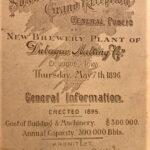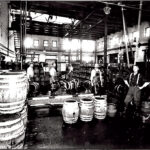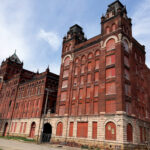The deteriorating, red brick Dubuque Brewing & Malting Co. building at 3000 and 3040 Jackson St. has been in the news recently. On May 18, the Dubuque City Council approved a rezoning request that will help building owner Steve Emerson, president of the design firm Aspect Inc., move forward with plans to create apartments, commercial office, and retail space in the 125-year-old former brewery.
The Dubuque Brewing & Malting Co. dates to 1892 when some fifty heirs of Dubuque’s four original brewers (Heeb, Glab, Meuser, and Tschirgi & Schwind) wanted to sell interests in their respective breweries, but the Clark Law made that impossible. So, they combined the breweries and established the Dubuque Malting Company, which promised to assume the heirs’ properties and pay them rent.
Soon, the A. Heeb Brewing Co., Northern Brewing Co., Iowa Brewery, and the Western Brewery formed a new company with an office at the Heeb Brewery at 2127 Couler (now Central Ave.). Officers of the new venture were Nicholas Glab – president and manager, John W. Schwind – vice president, and A.F. Heeb, – secretary and treasurer. Plans were made to relocate brewing operations on a ten-acre site at 30th and Jackson Streets.
Dubuque architects Fridolin Heer & Son got busy with the plans for a new, modern brewery – one that would use a $50,000 – $60,000 refrigeration plant instead of the traditional, outdated beer cellars and caves. Construction began in 1895 with an expected price tag of $250,000 – $275,000.
The new brewery was state-of-the-art for the times. The street-level frontage featured cream-colored Bedford stone. Pressed red brick was used for the remainder of the building. The building was built to last with two-foot thick walls, seven bricks deep. The complex boasted space for office, stock, brew, mill, boiler, machinery bottling, barn, wagon, garage, and additional small buildings. More than 200 electric lights lit the brewery as it operated around the clock. An artisan well with a six-inch-diameter output flow supplied water necessary for the operation of brewing. Building costs soared to $500,000.
On May 7, 1896, the Dubuque Brewing & Malting Co. celebrated its grand opening. The May 8, 1896 headlines of the Dubuque Sunday Herald proclaimed, “Thousands were there!” Some 20,000 flocked to the Jackson St. brewery to hear welcoming remarks made by company president Nicholas Glab as they scooped up souvenirs, devoured free food, and enjoyed music provided by the Dubuque Juvenile Band and the Original Italian Orchestra. Souvenir programs marking the occasion reported the brewery had an “annual capacity” of 300,000 barrels of beer.
As the serious business of brewing beer began, the 225,000-square-foot operation actually produced around 190,000 barrels annually. In Dubuque, electric trucks traveling six mph delivered beer. Out in the county and beyond, horse-drawn wagons, gas-powered trucks, and refrigerated railroad cars made deliveries. Local telephone orders were filled with home delivery between 7:00-9:00 PM.
The Dubuque Brewing & Malting Co. also owned some corporate saloons. When ordinances outlawed the ownership of saloons by breweries, the Dubuque Realty Company was formed to get around the law. The East Dubuque Supply Company was established to evade ordinances that limited sales to approved businesses. Beer sold to the Illinois company made its way back across the river and was sold in Iowa to anyone who wanted to buy.
But bigger, insurmountable trouble loomed. In 1915, the Iowa legislature repealed the Mulct Act, effectively outlawing saloons in the state. In 1918, an amendment to the state constitution barred alcoholic beverages. Iowa was one of 32 states to go “dry” before the 1919 national prohibition law went into effect. The Dubuque Brewing & Malting Co. stopped producing all but “near beer” rated at ½ % alcohol. Limited operations were moved to a company-owned site in Wisconsin. Rumors claimed that Al Capone used the Dubuque brewery to produce illegal beer shipped out in milk cans.
Ownership of the former brewery passed through many hands following the closure. Corn Belt Packing Co. began processing hogs in 1919. The Julien Dubuque Brewing Co. bought the building in 1933 and hoped to produce 1,000 barrels of beer daily, but failed. In 1937, officials announced that U.S. Sugar and Syrup Refineries had purchased the building for use as a corn products refinery. H&W Motor Express and the Dubuque Packing Co. bought the building in 1940 for $10,000 to be used as the H&W home office and for ham storage.
In 1977, the building was nominated for listing on the National Register of Historic Places. H&W and the Dubuque Packing Co. protested, saying the listing would prevent them from making improvements to the building. In 2005, the City of Dubuque protected the property from planned demolition by placing it within a conservation district. The building continued to deteriorate – sometimes, bricks fell to the sidewalks around the brewery.
In 2016, building owner Jim Krueger was cited for failing to have the building inspected by structural engineers. Court documents reported the building was an imminent danger to the general public. In July 2016, heavy rains caused part of the building’s roof to collapse. In August 2016, IIW engineers determined the midsection of the building was beyond salvage and needed to be demolished. On September 8, 2016, Jim Krueger revealed he had a buyer for the property.
In March 2017, it was announced that the former brewery had been sold to Cedar Rapids developer Steve Emerson. Hopefully, with the May 2020 rezoning vote, the Dubuque Brewing & Malting Co. building will be renovated and returned to its former glory – this time as an apartment and business complex.
This article is part of the Shades of Dubuque series, sponsored by Trappist Caskets, hand-made and blessed by the monks at New Melleray Abbey.







Connie
i own a small Bar in Byron Illinois and we recently removed our siding on the outside of our building only to find a logo Dubuque Malting co. with a logo attached
i’m looking for some info on how it may have gotten there.
Hi Bradley,
Here’s a reply from Connie:
“How exciting to find a historical sign on your building! I suspect it is an old advertisement for Dubuque Brewing and Malting products – similar to today’s billboards. The sign probably dates to the early 1900s and might have been painted by a local sign maker. You might find more information at your local historical society, or even in old city directories that might tell you about the background of your building and the businesses that occupied it at the turn of the last century.”
Thanks for reading!